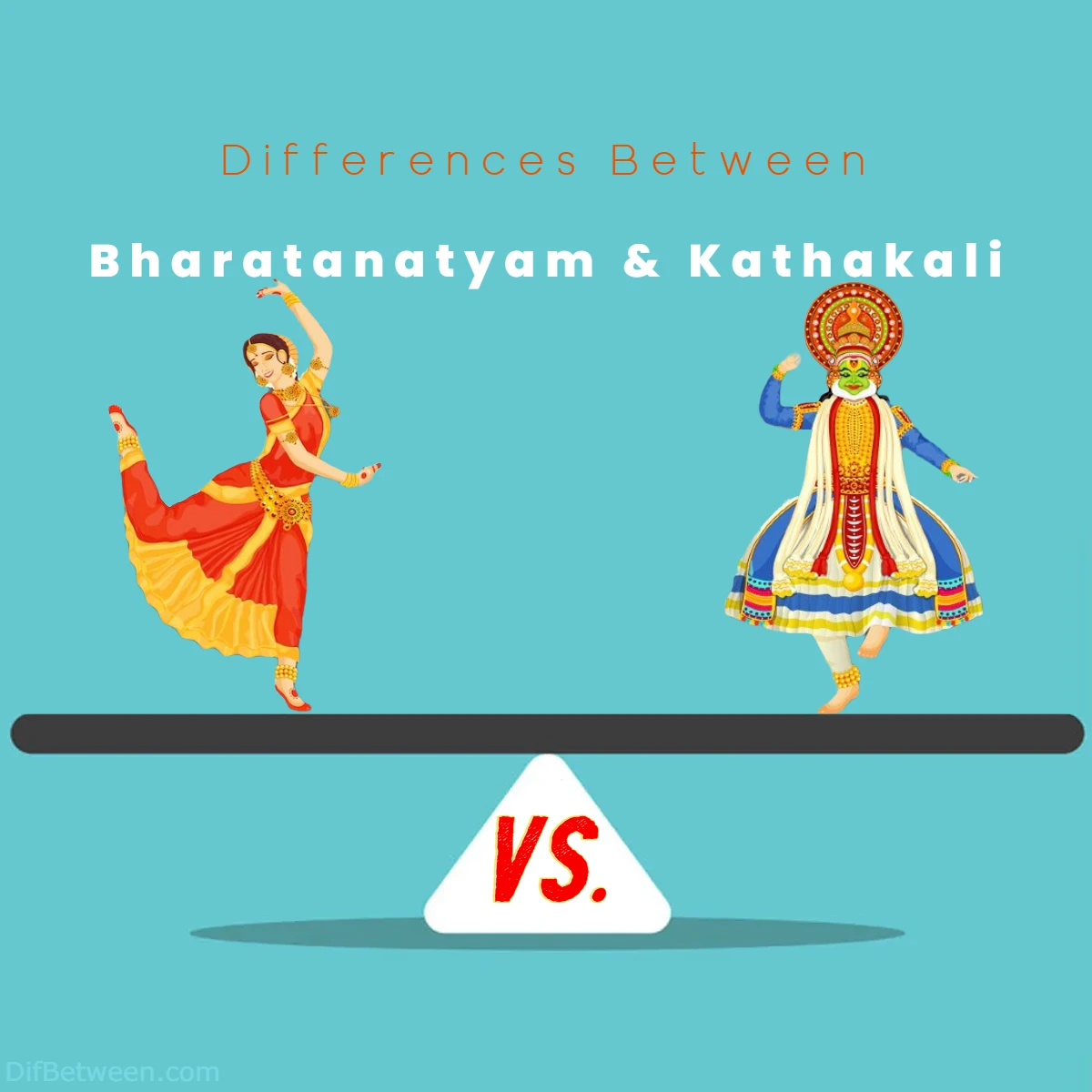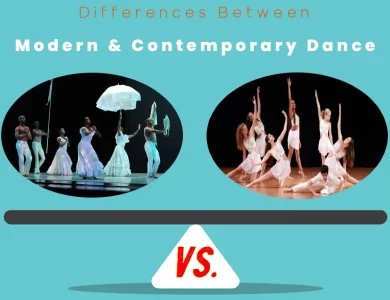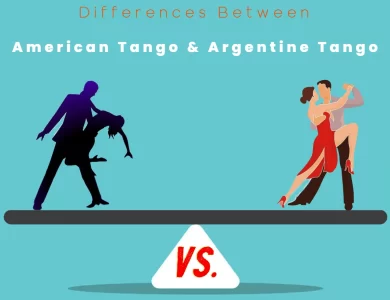
| Aspect | Bharatanatyam | Kathakali |
|---|---|---|
| Origin | Tamil Nadu, southern India | Kerala, southwestern India |
| Historical Roots | Over 2,000 years, temple dance | 17th century, courtly dance-drama |
| Expression Style | Subtle, precise, graceful | Dramatic, exaggerated, bold expressions |
| Movements | Linear, geometrical, structured | Dynamic, martial art-inspired movements |
| Music | Carnatic music, melodic rhythms | Percussion-dominant, rhythmic beats |
| Instruments | Nattuvangam, Mridangam, Veena | Chenda, Maddalam, vocalizations |
| Costumes | Simple and elegant | Elaborate, vibrant, headdresses |
| Makeup | Minimal, subtle | Elaborate, colorful, symbolic |
| Themes | Hindu mythology, devotion | Mythological epics, dramatic narratives |
| Training | Guru-Shishya tradition, holistic | Gurukul system, intensive character study |
| Physical Demand | Requires endurance and strength | Physically intense, martial art elements |
| Character Portrayal | Expressive, emotive | Dramatic, larger-than-life characters |
| Cultural Association | Primarily associated with Tamil Nadu | Originates from Kerala |
Bharatanatyam, originating from the vibrant state of Tamil Nadu, is a dance of precision, where every movement tells a story, and each gesture conveys a world of emotions. On the other side of the spectrum, Kathakali, born in the lush landscapes of Kerala, is a dance-drama extravaganza that immerses you in epic tales through extravagant costumes and bold expressions.
Differences Between Bharatanatyam and Kathakali
The main differences between Bharatanatyam and Kathakali lie in their origins and expressive styles. Bharatanatyam, rooted in Tamil Nadu, showcases precise and graceful movements, emphasizing devotion and storytelling through subtle expressions. In contrast, Kathakali, born in Kerala, captivates with dramatic and exaggerated expressions, elaborate costumes, and vibrant makeup, often depicting epic narratives and larger-than-life characters. These dance forms offer distinct cultural experiences, with Bharatanatyam focusing on Hindu mythology and spirituality, while Kathakali thrives on dramatic storytelling and visual extravagance.
Origin and History
Bharatanatyam: A Tale of Tamil Nadu
Bharatanatyam, often referred to as the “Mother of Indian Dance,” traces its roots to the southern Indian state of Tamil Nadu. This classical dance form is deeply entrenched in Hindu religious traditions, with its origins dating back over 2,000 years. It finds mention in ancient texts such as the Natya Shastra, a treatise on performing arts authored by Sage Bharata.
Bharatanatyam evolved in temples as a form of devotional expression, known as ‘Dasi Attam’ or ‘Sadira Attam.’ During the British colonial era, this art form faced a period of decline but experienced a revival in the 20th century, thanks to pioneers like Rukmini Devi Arundale. Today, Bharatanatyam is celebrated worldwide for its intricate footwork, graceful movements, and emotive storytelling.
Kathakali: The Dramatic Epic from Kerala
Kathakali, on the other hand, hails from the lush landscapes of Kerala, a southwestern state in India. This dance-drama form is a relatively recent addition to India’s classical dance repertoire compared to Bharatanatyam, with roots dating back to the 17th century.
Kathakali is renowned for its elaborate makeup, vibrant costumes, and dramatic storytelling. Unlike Bharatanatyam, which evolved in temples, Kathakali originated in the courts of Kerala’s rulers. It draws inspiration from ancient Sanskrit texts like the Ramayana and Mahabharata and combines dance, music, and acting to create a captivating theatrical experience.
Technique and Style
Bharatanatyam: Precision and Grace
Bharatanatyam is characterized by its precise and structured movements, focusing on linear and geometrical patterns. It places a strong emphasis on ‘Adavus,’ a set of basic steps that form the foundation of the dance. These Adavus are executed with utmost precision, demanding years of rigorous training to master.
The dance is performed in a straightforward, upright posture, with the upper body often remaining static while the lower body engages in intricate footwork. The expressions in Bharatanatyam are subtle yet powerful, with the dancer using their eyes, face, and hand gestures (‘Mudras’) to convey a range of emotions and stories.
Kathakali: The Art of Expression
Kathakali, in contrast, is known for its expressive and exaggerated movements. The dancers wear elaborate costumes, including towering headdresses, colorful makeup, and detailed facial expressions. The makeup in Kathakali is a form of art in itself, with specific colors and patterns representing different characters and emotions.
One of the striking features of Kathakali is its use of ‘Kalaari,’ or martial art movements, which add dynamism and vigor to the performances. The dancers often perform in a semi-sitting position, allowing for greater flexibility and dramatic body movements. The storytelling in Kathakali is intense and typically revolves around mythological tales and legends.
Music and Instruments
Bharatanatyam: Melodic Rhythms
Music plays a pivotal role in Bharatanatyam, providing the rhythm and melody that guide the dancer’s movements. The primary musical accompaniment for Bharatanatyam is the ‘Nattuvangam,’ a set of cymbals played by the ‘Nattuvanar,’ who also serves as the conductor of the performance.
The vocal component in Bharatanatyam includes classical Carnatic music, with singers rendering intricate compositions in languages like Tamil, Telugu, or Sanskrit. Other instruments like the ‘Mridangam’ (a double-headed drum) and the ‘Veena’ (a string instrument) complement the dance, creating a harmonious blend of music and movement.
Kathakali: Rhythmic Percussions
Kathakali places a strong emphasis on percussion instruments to create a powerful and dramatic atmosphere. The ‘Chenda,’ a cylindrical drum, and the ‘Maddalam,’ a double-headed drum, are essential in Kathakali performances. The thunderous beats of these instruments set the tone for the elaborate storytelling.
While music and vocals also play a role in Kathakali, the dance often relies on a unique vocalization style called ‘Solkattu’ or ‘Konakkol’ for rhythm. The makeup and costumes of the characters are so intricate and detailed that they serve as visual cues, conveying the mood and personality of each character.
Costumes and Makeup
Bharatanatyam: Elegance in Simplicity
Bharatanatyam costumes are known for their simplicity and elegance. Female dancers typically wear a traditional attire called the ‘Pattu Pavadai’ or ‘Langa Voni,’ consisting of a pleated skirt, blouse, and a sari draped in a distinctive way. The jewelry is minimal, with the focus primarily on the dance movements.
Makeup in Bharatanatyam is comparatively subtle, with a few basic lines and dots used to enhance facial expressions. The hair is usually tied up in a neat bun, adorned with flowers or ornaments. This simplicity allows the audience to focus on the dancer’s movements and expressions.
Kathakali: A Visual Extravaganza
Kathakali costumes and makeup are a visual spectacle in themselves. The characters are divided into ‘Pacha’ (green), ‘Kathi’ (knife), ‘Thadi’ (beard), and ‘Minukku’ (feminine) based on their makeup styles. Each character’s makeup takes hours to apply and is an art form in its own right.
The costumes in Kathakali are elaborate and feature vibrant colors, heavy jewelry, and towering headdresses. The facial makeup, which includes bold lines and colorful patterns, transforms the performers into larger-than-life characters. This attention to detail adds to the overall dramatic impact of Kathakali performances.
Themes and Stories
Bharatanatyam: Mythology and Devotion
Bharatanatyam often draws inspiration from Hindu mythology and religious texts. Dancers use this art form to depict stories of gods and goddesses, such as Lord Shiva, Lord Krishna, or Goddess Parvati. The performances are a form of devotion and a means of connecting with the divine.
The storytelling in Bharatanatyam is subtle, with the focus on portraying the emotions and essence of the characters. It’s a spiritual journey where the dancer and the audience explore the depths of mythology and spirituality through graceful movements and expressions.
Kathakali: Epics and Legends
Kathakali, on the other hand, specializes in the retelling of epic tales and legends. Performances often revolve around characters from the Ramayana and Mahabharata, such as Rama, Sita, Ravana, or Arjuna. The dance-drama format allows for more explicit and vivid storytelling.
Kathakali’s dramatic elements, including the makeup, costumes, and exaggerated movements, contribute to its ability to bring these epic narratives to life. The audience is transported to a world of heroism, valor, and mythical adventures as they witness the unfolding of these timeless stories.
Training and Guru-Shishya Parampara
Bharatanatyam: Guru’s Blessings
In the realm of Bharatanatyam, the tradition of ‘Guru-Shishya Parampara’ (teacher-student relationship) holds immense significance. Dancers undergo rigorous training under the guidance of a ‘Guru’ (teacher) who imparts not only the technical aspects of the dance but also the spiritual and philosophical dimensions.
This training often begins at a young age and involves years of dedication and practice. Students learn not only the dance sequences but also the intricacies of music, rhythm, and storytelling. The bond between the Guru and the Shishya is a deeply revered and cherished aspect of Bharatanatyam.
Kathakali: The Intensive Gurukul
Kathakali training is equally demanding and follows the Gurukul system. Students, known as ‘Kalari,’ live with their Guru in a traditional Gurukul setting, immersing themselves fully in the art form. The training includes physical conditioning, makeup techniques, and extensive rehearsals.
Kathakali demands a high level of physical fitness due to its dynamic movements and martial art elements. The Guru not only teaches the technical aspects but also guides the students in understanding the intricate emotions and expressions required for each character. This intense training process prepares them for the grandeur of Kathakali performances.
Popular Performances and Notable Artists
Bharatanatyam: Legendary Dancers
Over the years, Bharatanatyam has produced legendary artists who have left an indelible mark on the dance world. Some of the most celebrated Bharatanatyam dancers include Rukmini Devi Arundale, Balasaraswati, Yamini Krishnamurthy, and Alarmel Valli. Their contributions have not only popularized the art form but also pushed the boundaries of innovation.
Bharatanatyam has also found its place on the global stage, with dancers like Shobana Chandrakumar Pillai and Priyadarsini Govind captivating audiences worldwide. Their performances have bridged cultural gaps and introduced the beauty of Bharatanatyam to diverse audiences.
Kathakali: Masters of the Epic
Kathakali has its own share of iconic performers who have elevated the art form to new heights. Legendary Kathakali artists like Kalamandalam Krishnan Nair, Kalamandalam Gopi, and Padma Shri Kalamandalam Ramankutty Nair have been torchbearers of this rich tradition.
These artists are known for their remarkable portrayals of characters from epics and their mastery of Kathakali’s intricate techniques. Their contributions have ensured that Kathakali remains a vibrant and culturally significant art form in India.
Bharatanatyam or Kathakali: Which One is Right Choose for You?
Choosing between Bharatanatyam and Kathakali can be a delightful yet challenging decision. Both are beautiful and culturally rich Indian classical dance forms, each with its unique charm and characteristics. To help you decide which one might be the right choice for you, consider the following factors:
1. Personal Preference for Expression
Bharatanatyam: If you appreciate subtle and graceful expressions that convey a wide range of emotions with intricate hand gestures and facial expressions, Bharatanatyam might be your preference. It focuses on storytelling through a spiritual and devotional lens, often portraying mythological tales.
Kathakali: If you lean towards dramatic and exaggerated expressions with bold makeup and elaborate costumes, Kathakali could be your choice. Kathakali’s emphasis is on creating a vivid and larger-than-life portrayal of characters and epic narratives.
2. Physical Fitness and Stamina
Bharatanatyam: While both dance forms require physical fitness, Bharatanatyam’s movements are more precise and controlled. It demands endurance and strength but may be less physically demanding compared to Kathakali.
Kathakali: Kathakali requires a higher level of physical fitness due to its dynamic movements, martial art elements, and the weight of costumes and headdresses. It’s physically intense and requires robust stamina.
3. Interest in Mythology and Spirituality
Bharatanatyam: If you have a deep interest in Hindu mythology and spirituality and enjoy the idea of using dance as a means of connecting with the divine, Bharatanatyam aligns well with these themes.
Kathakali: Kathakali is an excellent choice if you are passionate about Indian epics like the Ramayana and Mahabharata. It provides a platform to immerse yourself in the grand narratives and heroic characters of these epics.
4. Makeup and Costume Preference
Bharatanatyam: If you prefer simplicity in attire and minimal makeup, Bharatanatyam’s elegant costumes and subtle makeup might be more appealing.
Kathakali: If you’re fascinated by vibrant costumes, intricate makeup, and the visual spectacle of elaborate headdresses, Kathakali’s extravagant style could be a draw for you.
5. Long-Term Commitment
Bharatanatyam: Bharatanatyam offers a slightly shorter learning curve compared to Kathakali. It’s suitable if you want to embark on a classical dance journey but have limited time for intensive training.
Kathakali: If you’re willing to invest more time and effort in a longer and more immersive training process, Kathakali’s Gurukul system and extensive character study might be a rewarding path.
6. Cultural and Regional Affiliation
Consider your cultural and regional affiliations. Bharatanatyam is primarily associated with the southern Indian state of Tamil Nadu, while Kathakali originates from Kerala in the southwest. Your cultural background or affinity for a specific region may influence your choice.
Ultimately, the decision between Bharatanatyam and Kathakali should align with your personal interests, artistic inclinations, and the commitment you’re willing to make. Both dance forms are treasures of Indian culture, offering a profound and fulfilling artistic journey for those who embrace them. Whichever you choose, you’ll be part of a rich tradition that continues to inspire and captivate audiences around the world.
FAQs
Bharatanatyam originates from Tamil Nadu, a state in southern India, while Kathakali hails from Kerala, a southwestern state in India.
Bharatanatyam is characterized by subtle and graceful movements, focusing on precision and devotion, while Kathakali features dramatic and exaggerated expressions with elaborate makeup and costumes, often portraying epic narratives.
Bharatanatyam often revolves around Hindu mythology and spirituality, with dancers depicting stories of gods and goddesses. Kathakali, on the other hand, specializes in mythological epics like the Ramayana and Mahabharata, bringing heroes and villains to life.
Bharatanatyam costumes are simple and elegant, with minimal makeup. Kathakali costumes are elaborate, featuring vibrant colors, heavy jewelry, and intricate makeup, transforming performers into larger-than-life characters.
Both dance forms follow traditional training methods. Bharatanatyam involves the Guru-Shishya Parampara, with students undergoing rigorous training in dance, music, and spirituality. Kathakali students live in a Gurukul, where they receive intensive training in character study and physical conditioning.
Kathakali is generally more physically demanding due to its dynamic movements, martial art elements, and elaborate costumes. Bharatanatyam also requires physical fitness but is often perceived as less physically intense.
Yes, Bharatanatyam is primarily associated with Tamil Nadu, and Kathakali has strong ties to Kerala. Your cultural background or regional affinity may influence your preference for one over the other.
Absolutely! Both dance forms offer captivating and culturally rich experiences. You can appreciate and enjoy the beauty of both Bharatanatyam and Kathakali as an audience member, appreciating their unique qualities.
Read More:
Contents




